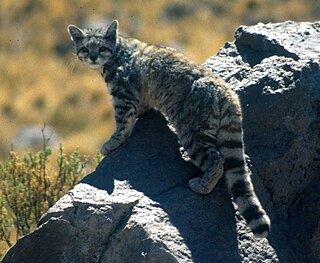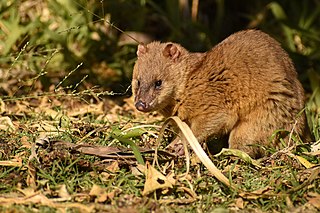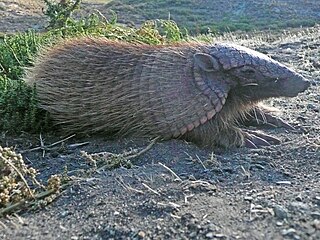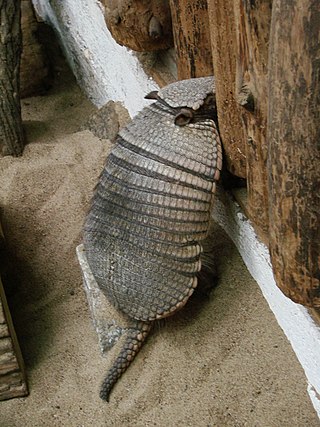
Armadillos are New World placental mammals in the order Cingulata. The Chlamyphoridae and Dasypodidae are the only surviving families in the order, which is part of the superorder Xenarthra, along with the anteaters and sloths. Nine extinct genera and 21 extant species of armadillo have been described, some of which are distinguished by the number of bands on their armor. All species are native to the Americas, where they inhabit a variety of different environments.

Xenarthra is a major clade of placental mammals native to the Americas. There are 31 living species: the anteaters, tree sloths, and armadillos. Extinct xenarthrans include the glyptodonts, pampatheres and ground sloths. Xenarthrans originated in South America during the late Paleocene about 60 million years ago. They evolved and diversified extensively in South America during the continent's long period of isolation in the early to mid Cenozoic Era. They spread to the Antilles by the early Miocene and, starting about 3 Mya, spread to Central and North America as part of the Great American Interchange. Nearly all of the formerly abundant megafaunal xenarthrans became extinct at the end of the Pleistocene.

The Andean mountain cat is a small wild cat native to the high Andes that has been listed as Endangered on the IUCN Red List because fewer than 1,500 individuals are thought to exist in the wild. It is traditionally considered a sacred animal by indigenous Aymara and Quechua people.

The northern hairy-nosed wombat or yaminon is one of three extant species of Australian marsupials known as wombats. It is one of the rarest land mammals in the world and is critically endangered. Its historical range extended across New South Wales, Victoria, and Queensland as recently as 100 years ago, but it is now restricted to one place, a 3 km2 (1.2 sq mi) range within the 32 km2 (12 sq mi) Epping Forest National Park in Queensland. With the species threatened by wild dogs, the Queensland Government built a 20-kilometre (12 mi)-long predator-proof fence around all wombat habitat at Epping Forest National Park in 2002.

The six-banded armadillo, also known as the yellow armadillo, is an armadillo found in South America. The sole extant member of its genus, it was first described by Swedish zoologist Carl Linnaeus in 1758. The six-banded armadillo is typically between 40 and 50 centimeters in head-and-body length, and weighs 3.2 to 6.5 kilograms. The carapace is pale yellow to reddish brown, marked by scales of equal length, and scantily covered by buff to white bristle-like hairs. The forefeet have five distinct toes, each with moderately developed claws.

The nine-banded armadillo, also known as the nine-banded long-nosed armadillo or common long-nosed armadillo, is a mammal found in North, Central, and South America, making it the most widespread of the armadillos. Its ancestors originated in South America, and remained there until the formation of the Isthmus of Panama allowed them to enter North America as part of the Great American Interchange. The nine-banded armadillo is a solitary, mainly nocturnal animal, found in many kinds of habitats, from mature and secondary rainforests to grassland and dry scrub. It is an insectivore, feeding chiefly on ants, termites, and other small invertebrates. The armadillo can jump 91–120 cm (3–4 ft) straight in the air if sufficiently frightened, making it a particular danger on roads. It is the state mammal of Texas.

The greater long-nosed armadillo is a South American species of armadillo found in Colombia, Venezuela, Ecuador, Guyana, Suriname, French Guiana, Peru, Bolivia and Brazil. It is a solitary, nocturnal, terrestrial animal that feeds on arthropods and other invertebrates, usually living in the vicinity of streams and swamps.

The big lutrine opossum, also called little water opossum, thick-tailed opossum and coligrueso, is a long-tailed, otter-like mammal native to grasslands of South America. It generally lives near water and is active at night, dawn or dusk. It eats mice, insects and crabs. Like all opossums, it is a marsupial.
Hairy armadillo may refer to:

The screaming hairy armadillo is a species of armadillo also known as the small screaming armadillo, crying armadillo or the small hairy armadillo. It is a burrowing armadillo found in the central and southern parts of South America. The adjective "screaming" derives from its habit of squealing when handled.

Chaetophractus is a small genus of armadillos in the family Chlamyphoridae. It contains the following three species:

The bighairy armadillo is one of the largest and most numerous armadillos in South America. It lives from sea level to altitudes of up to 1,300 meters across the southern portion of South America, and can be found in grasslands, forests, and savannahs, and has even started claiming agricultural areas as its home. It is an accomplished digger and spends most of its time below ground. It makes both temporary and long-term burrows, depending on its food source.

The greater fairy armadillo, also known as Burmeister's armadillo or the Chacoan fairy armadillo, is a species of armadillo in the family Chlamyphoridae. It is found in Argentina, Bolivia, and Paraguay. Its natural habitats are subtropical or tropical dry shrubland and subtropical or tropical dry lowland grassland. It is threatened by habitat loss and persecution. It is the only species in the genus Calyptophractus.

Dasypus is the only extant genus in the family Dasypodidae. Its species are known as long-nosed or naked-tailed armadillos. They are found in South, Central, and North America, as well as on the Caribbean islands of Grenada, Trinidad and Tobago. Members of Dasypus are solitary and primarily nocturnal to avoid temperature extremes and predation. They exist in numerous habitats ranging from brush to grassland areas and are mainly insectivorous.

Turco Municipality is the second municipal section of the Sajama Province in the Oruro Department in Bolivia, and was founded on February 15, 1957. Its seat is Turco, situated 154 km west of Oruro at an altitude of 3,860 m. The municipality covers an area of 3,973 km², not taking into account the area of Laca Laca Canton.

Chlamyphoridae is a family of cingulate mammals. While glyptodonts have traditionally been considered stem-group cingulates outside the group that contains modern armadillos, there had been speculation that the extant family Dasypodidae could be paraphyletic based on morphological evidence. In 2016, an analysis of Doedicurus mtDNA found it was, in fact, nested within the modern armadillos as the sister group of a clade consisting of Chlamyphorinae and Tolypeutinae. For this reason, all extant armadillos but Dasypus were relocated to a new family.

The High Monte is a montane grasslands and shrublands ecoregion in Argentina.

















